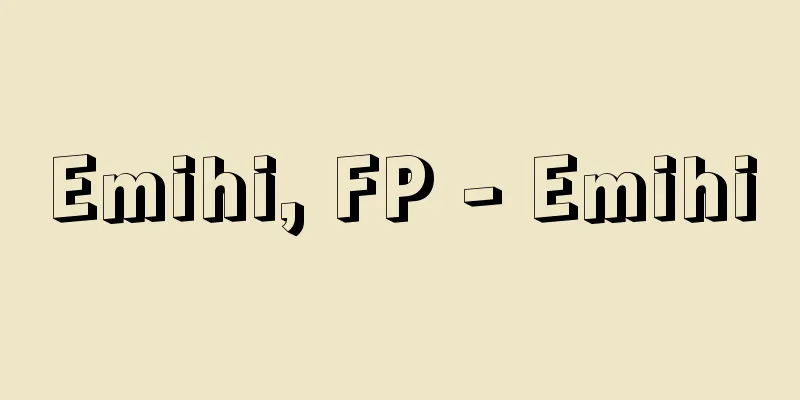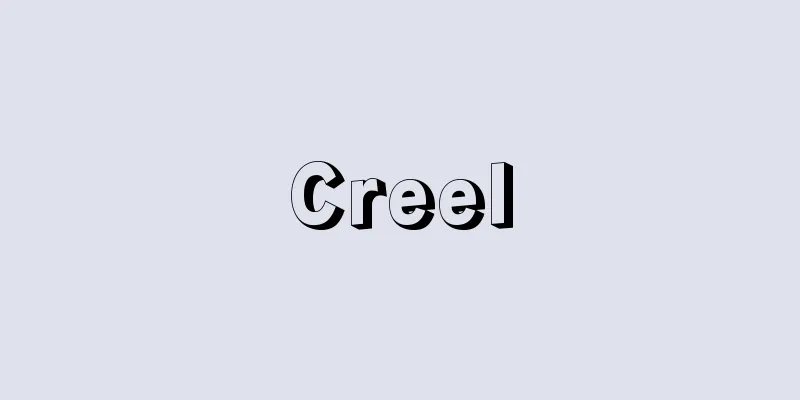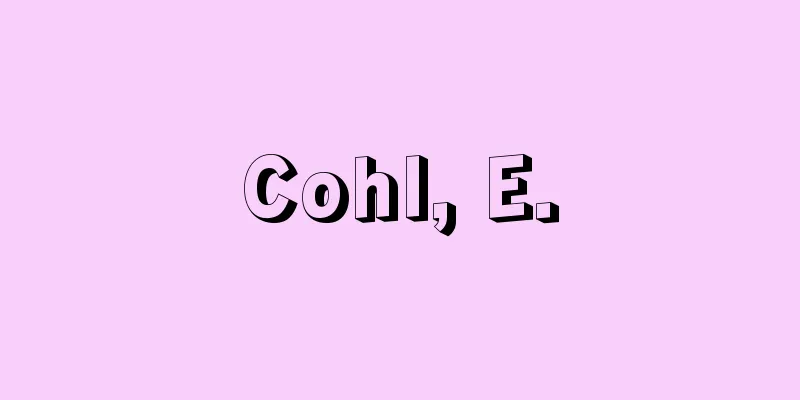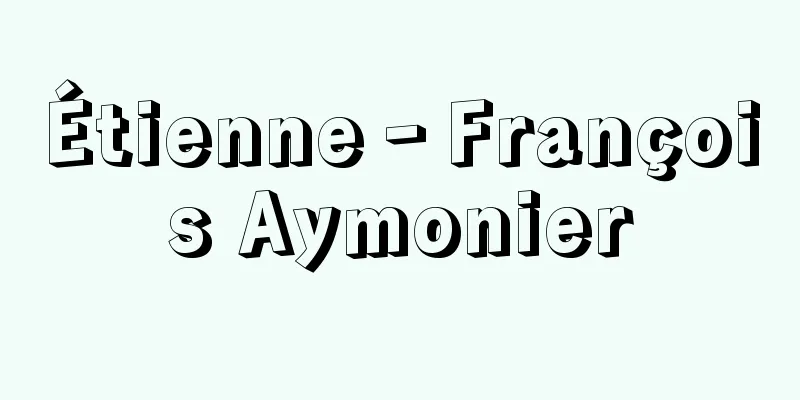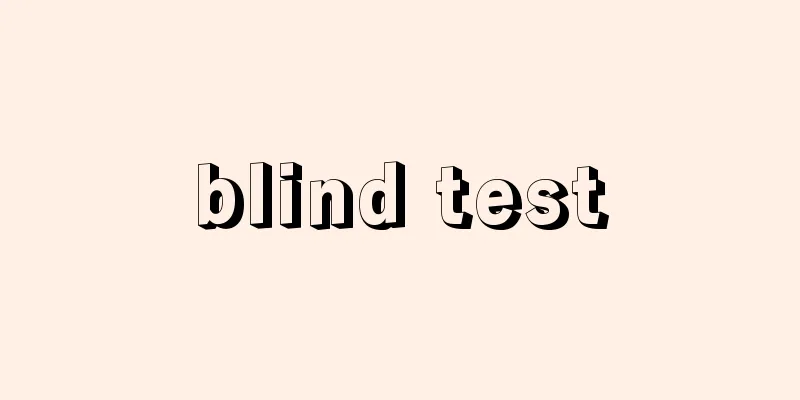Gabon - Gabon (English spelling)
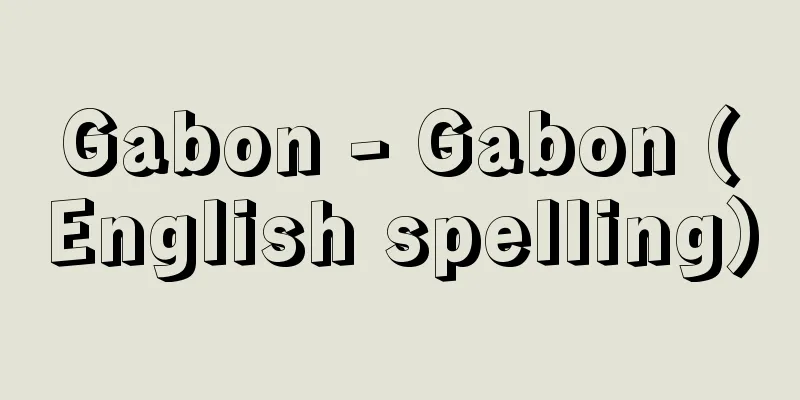
|
A country in central-western Africa facing the Gulf of Guinea. Its official name is the Gabonese Republic (République Gabonaise). The country borders the Mbini region of Equatorial Guinea and Cameroon to the north, and the Republic of the Congo to the east and south. The equator runs almost through the center of the country, so it is literally a country on the equator. It has an area of 267,667 square kilometers and a population of 1.21 million (estimated as of 2000). The capital is Libreville. [Nobuyuki Hashimoto] NatureGabon faces the Gulf of Guinea to the west, and its topography increases inland from the coast. It can be roughly divided into three regions: the coastal lowlands, the inland plateau, and the inland highlands. The Ogooué River, the country's largest river, flows west from the inland highlands, which form the watershed, forming a large valley. A coastal lowland stretching 30 to 200 kilometers wide stretches along the coastline, which, due to the influence of the cold Benguela Current flowing northward, has numerous sandbars and lagoons that have developed northward, making it intricate like a ria coast. Cape Lopez, which developed at the mouth of the Ogooué River, is a typical example. The inland highlands are 500 to 700 meters above sea level, and are generally gently undulating, but many rivers have carved valleys into them. These inland highlands make up the majority of the country's land area, with the northern and southern parts being inland highlands. The highest peak in the country is Mount Ibndi (1,580 metres) in the Shail Mountains in the south. The country has a hot and humid tropical rainforest climate, with an average annual temperature of 25-27°C and an average annual rainfall of over 1,500 mm. The coastal areas receive particularly high rainfall, with the capital, Libreville, receiving as much as 3,000 mm per year. With the exception of the savannah of the inland highlands, most of the country is covered in tropical rainforest, which provides a wealth of useful timber, including okoumé wood, which is used for plywood. [Nobuyuki Hashimoto] historyThe history of this region before the 15th century is unclear, but when the Portuguese arrived in the latter half of the 15th century, the Bantu people of the Loango Kingdom had been established in the lower reaches of the Ogoue River. From the 16th century onwards, the Dutch, British and French arrived, but most of the trade with the indigenous people was conducted by the Portuguese. The start of French colonization came when Governor Boué of the French Navy acquired land at the mouth of the Gabon River through an agreement with the tribal chiefs for the purpose of controlling the slave trade, built a fort there in 1843, and in 1849 freed the slaves from a captured slave ship and settled there, naming the place Libreville (free city). Meanwhile, the inland Ogooué River basin was explored by de Brazza, and Franceville was built. Thus, France appointed a governor in Gabon in 1886, made it part of the French Congo from 1889 to 1904, and then made it a colony of French Equatorial Africa from 1910. After the Second World War, as a French overseas territory, it had its own parliament, became an autonomous republic within the French Community in 1958, and gained independence in 1960. Mba was elected as the first president in 1961, but he died in 1967 due to poor health, and Bongo, who had been vice president, was promoted to president. [Nobuyuki Hashimoto] PoliticsAlthough there was one military coup after independence, President Bongo established the Gabonese Democratic Party as a single political party in 1968 immediately after taking office, and the political situation has remained relatively stable under a dictatorial system. The vice-presidential system was later abolished, and a cabinet was formed under a prime minister and deputy prime minister system. Since 1975, the country has been a member of the Organization of Petroleum Exporting Countries (OPEC). In 1990, the country announced the adoption of a multi-party system, and although there was temporary confusion, the country is exploring the direction of democratization, such as holding parliamentary elections under the new system. Bongo was elected president in 1993 and again in 1998, achieving a sixth term. [Nobuyuki Hashimoto] economyIt is no exaggeration to say that Gabon's current economy is supported by oil, which began to be extracted in 1956. 50-60% of the government budget depends on oil export revenues, and oil accounts for more than 80% of exports. However, reserves are said to be small, and oil production has been declining since the 1980s. Furthermore, the instability of international oil prices has worsened the country's economy. The second largest export after oil is timber. In particular, the famous okoumé wood is the main timber export for use in plywood, accounting for nearly 90% of log exports. In addition, forestry and plywood industries centered on okoumé wood have a large capacity to absorb jobs in the country, and there is a large processing plant at the export port of Port Gentil. However, the okoumé resources near the coast have been depleted recently, and the development of timber inland has become a major issue. Manganese and uranium are important underground resources other than oil, accounting for 7% and 12% of total exports, respectively. The manganese deposits in Mwanda, near Franceville in southeastern Gabon, are said to account for one-quarter of the world's reserves, producing more than 2 million tons per year. Uranium deposits in Mounana, also near Franceville, produce more than 1,000 tons per year. There were problems with transporting these underground resources, but a railway was opened in 1986. Compared to these underground resources and forestry, the country's agriculture is in a state of extreme slump, given that 77% of the land area is covered by forests. The main form of agriculture is self-sufficiency, which accounts for only 5% of the gross national product (GNP), and the current situation is that 50% of food is imported. Structural reform of agriculture is necessary to change the economic structure, and currently the government is implementing a policy of agricultural investment centered on rice, oil palm, rubber, and coconut. Manufacturing industries are centered on chemicals (petroleum refining) and building materials, and are generally sluggish. [Nobuyuki Hashimoto] Society and CultureThe country has a small population and abundant underground resources, so its per capita income is the seventh highest in Africa (1995), and its standard of living has improved rapidly. However, it is heavily dependent on imports for food and other necessities, and the cost of living in the capital, Libreville, is the highest in the world. Approximately 520,000 people are concentrated in Libreville, with other major cities such as Port-Gentil, Franceville, and Lambaréné having large populations, resulting in an extremely high urban population rate. The education system is well-developed following the example of France, and in the field of specialized education there are four technical high schools and 12 vocational training centers, and the country is also focusing on technical education. The primary school enrollment rate is said to be 80%, which is extremely high among African countries. The National Institute of Education was established in 1970, and the government is making efforts to spread education and improve its standards. Medical facilities have been improved in recent years, and the hospital in Lambaréné commemorating Schweitzer is world-famous. The population is mainly made up of Bantu-speaking tribes, the most powerful of which is the Fang. Other prominent tribes include the Esilah, Aduma, Okande and Bakota. In terms of language, these tribal languages are widely spoken, and French has been adopted as the official language. In terms of religion, each tribe has its own traditional beliefs, but Catholicism has a long history of missionary work, and today Catholics make up 60% of the population. Gabon's national life, coupled with its economic characteristics and high urban population rate, is characterized by a large disparity between urban and rural dwellers. [Nobuyuki Hashimoto] Relations with JapanTrade with Japan is expanding year by year, with exports to Japan reaching approximately 20.6 billion yen and imports from Japan reaching approximately 8.1 billion yen in 1991. Japan's assistance is expected in the development of the country's abundant underground resources and in promoting the agricultural and fishery industries. [Nobuyuki Hashimoto] [Supplementary Material] |"> Gabon flag ©Shogakukan Illustration/Shogakukan Creative "> Gabon Location Map Source: Shogakukan Encyclopedia Nipponica About Encyclopedia Nipponica Information | Legend |
|
アフリカ中西部、ギニア湾に面した国。正称はガボン共和国République Gabonaise。国土の北は赤道ギニアのムビニ州およびカメルーンと接し、東と南はコンゴ共和国と接している。国土のほぼ中央を赤道が走り、文字どおり赤道直下の国である。面積26万7667平方キロメートル、人口121万(2000推計)。首都はリーブルビル。 [端 信行] 自然西がギニア湾に面したガボンの地勢は、海岸から内陸に向かうにしたがってその高度を増し、地形的には沿岸低地、内陸高原、内陸高地の3地域に大別される。分水嶺(ぶんすいれい)をなす内陸高地からこの国の最大河川であるオゴウエ川が西流し、大きな谷を形成している。幅30~200キロメートルにわたる沿岸低湿地帯が海岸線に沿って広がっており、その海岸線は、北方向に流れるベンゲラ寒流の影響により、北向きに発達した砂州やラグーンが数多くあって、あたかもリアス式海岸のように入り組んでいる。オゴウエ川河口に発達したロペス岬はその代表的な例である。内陸高原は標高500~700メートルの、全体として起伏の緩やかな高原であるが、多くの河川によって谷が刻まれている。この内陸高原が国土の過半を占めており、その北部と南部とが内陸高地となっている。国内最高峰は南部のシャイユ山脈のイブンディ山(1580メートル)である。 気候は年平均気温25~27℃で、年間1500ミリメートル以上の降水量があり、高温多湿な熱帯雨林気候となっている。沿岸部はとりわけ雨量が多く、首都リーブルビルでは年間3000ミリメートルにも達する。植生は、内陸高地のサバンナを除くと、国土の大部分が熱帯雨林で覆われているため、合板用材のオクメ材をはじめ有用材も数多くみられる。 [端 信行] 歴史15世紀以前のこの地方の歴史は明らかにされていないが、15世紀の後半にポルトガル人がこの地に来航したころには、オゴウエ川の下流を中心にバントゥー系の民族によるロアンゴ王国が形成されていた。16世紀以降、オランダ人、イギリス人、フランス人などが来航したが、先住民との取引の大部分はポルトガル人が中心であった。 フランスによる植民が進むきっかけとなったのは、フランス海軍の総督ブーエが奴隷貿易取締りの目的でガボン川河口の土地を族長との協定で入手し、1843年にここに砦(とりで)を築き、1849年には拿捕(だほ)した奴隷船の奴隷を解放して入植させ、この地をリーブルビル(自由の町)と命名させたことによる。一方、内陸部のオゴウエ川流域はド・ブラザによって探検され、フランスビルが築かれた。こうしてフランスは1886年にガボンに総督を置き、1889年から1904年にかけてはフランス領コンゴの一部とし、ついで1910年からはフランス領赤道アフリカの一植民地とした。 第二次世界大戦後はフランス海外領の一つとして独自の議会をもつこととなり、1958年にはフランス共同体の自治共和国となり、60年に独立した。61年にはムバが初代大統領に選出されたが、病身のムバは67年死去、副大統領だったボンゴが大統領に昇進した。 [端 信行] 政治独立後に軍によるクーデターが一度あったものの、大統領ボンゴはその就任直後の1968年に単一政党としてのガボン民主党を設立、政情は独裁体制で比較的安定している。その後、副大統領制を廃し、首相・副首相制のもとに内閣を組織している。75年から石油輸出国機構(OPEC(オペック))のメンバーである。90年には複数政党制度の採用を発表し、一時的混乱はあったが、新制度のもとで国会議員選挙を実施するなど、民主化への方向が模索されている。93年、98年の大統領選挙でもボンゴが当選し、6選を果たしている。 [端 信行] 経済現在のガボンの経済は1956年から採掘の始まった石油によって支えられているといっても過言ではない。政府予算の50~60%は石油輸出収入に依存しており、輸出高の80%以上を石油が占める。しかし埋蔵量は少ないといわれており、80年代以降この石油の産出量が減産傾向にある。さらには石油国際価格の不安定がこの国の経済を悪化させている。石油に次いで輸出高が大きいのは木材である。とくに名産のオクメ材は合板用として木材輸出の中心で、原木輸出の90%近くを占めている。またこのオクメ材中心の林業、合板工業は国内における雇用吸収力も大きく、輸出港ポール・ジャンティルには大規模な加工工場がある。しかし最近では海岸に近いオクメ資源は枯渇しつつあり、内陸の木材開発が大きな課題となっている。 石油以外の地下資源ではマンガンとウラニウムが重要で、それぞれ輸出総額の7%、12%を占めている。ガボン南東部のフランスビルに近いムワンダのマンガン鉱脈は世界の埋蔵量の4分の1を占めるといわれ、年間200万トン以上を産出している。また同じフランスビルに近いムウナナのウラニウムは年間1000トン以上を生産している。これらの地下資源の輸送には問題があったが、1986年に鉄道が開通した。 こうした地下資源や林業に比べると、この国の農業は、国土の77%が森林に覆われているだけに、きわめて不振をかこっている状態である。農業形態は自給的農業が中心で、国民総生産(GNP)の5%にしかすぎず、食糧の50%を輸入しているのが現状である。経済構造を変えるためにも農業の構造改革が必要で、現在は米、アブラヤシ、ゴム、ココヤシを中心とした農業投資の政策がとられている。製造工業は化学(石油精製)、建材が中心で、一般に低調である。 [端 信行] 社会・文化この国は人口が少なく、地下資源が豊富であるため、1人当りの国民所得はアフリカ第7位(1995)で、表面上の生活水準は急速に向上したとされている。しかし食糧など生活必需品を輸入に大きく依存しており、首都のリーブルビルの物価は世界一高い。約52万人がリーブルビルに集中し、ほかにポール・ジャンティル、フランスビル、ランバレネなどの主要都市に人口が多く、その結果、都市人口率がきわめて高くなっている。また教育制度はフランスに倣ってかなり整備されており、専門教育の分野でも4工業高校、12の職業訓練センターがあり、技能教育にも力を入れている。初等教育の就学率は80%に達するといわれており、アフリカ諸国のなかではきわめて高い水準にある。1970年には国立教育研究所が創設され、政府は教育の普及と水準向上に力を入れている。近年は医療施設も充実されてきたが、なかでも、ランバレネのシュワイツァーを記念した病院は、世界的に知られている。 住民構成はバントゥー語系部族が中心で、なかでももっとも勢力のあるのはファンである。ほかにエシラ、アドゥマ、オカンデ、バコタなどが有力である。言語生活ではこうした部族語が広く話されているほか、公用語としてはフランス語が採用されている。宗教生活ではそれぞれの部族が伝統的信仰をもつが、カトリックの布教の歴史は古く、今日ではカトリック教徒が人口の60%を占めている。こうしたガボンの国民生活は、その経済的特徴や都市人口率の高さと相まって、都市住民と農村居住者との間の格差が大きいのが特色である。 [端 信行] 日本との関係日本との貿易は年々拡大しており、1991年では日本への輸出は約206億円、日本からの輸入は約81億円に達している。豊富な地下資源の開発や農水産業の振興などに日本の援助が期待されている。 [端 信行] [補完資料] |"> ガボンの国旗 ©Shogakukan 作図/小学館クリエイティブ"> ガボン位置図 出典 小学館 日本大百科全書(ニッポニカ)日本大百科全書(ニッポニカ)について 情報 | 凡例 |
<<: Gapon, Georgii Apollonovich
>>: Gaborone (English spelling)
Recommend
Osunapal - Osunapal
…Legendary Assyrian king. He is sometimes identif...
Somateriini
... Merganetta armata (torrent duck) is one speci...
Zodiac
If you observe the position of the Sun in relatio...
Zamenhof - Lazaro Ludoviko Zamenhof
The creator of the international auxiliary langua...
Sergiev Posad
A city in Moscow Oblast, western European Russia, ...
Action film
A film that emphasizes external actions (action) r...
Australian Ironwood
…It is a unique plant with no particularly closel...
A brief history of Kabuki music
Title of the book. Written by Konakamura Kiyonori...
Kuvera flaviceps (English spelling) Kuveraflaviceps
...In Japan, they are commonly found among grass ...
Art Institute of Chicago
Along with the Metropolitan Museum of Art and the...
"Song of Kannan" - Kannan no Uta
…He was an ardent follower of the goddess Shakti,...
Geiger, T.
…This originated from Weber and R. Pound and is o...
long-tailed ground roller
…Generally, their plumage is slightly more pale t...
Cassiope lycopodioides (Pall.) D.Don
A small shrub of the Ericaceae family that grows i...
Ratanakosin Dynasty - Ratanakosin
The current dynasty of Thailand. It was founded in...

